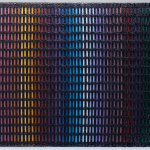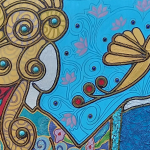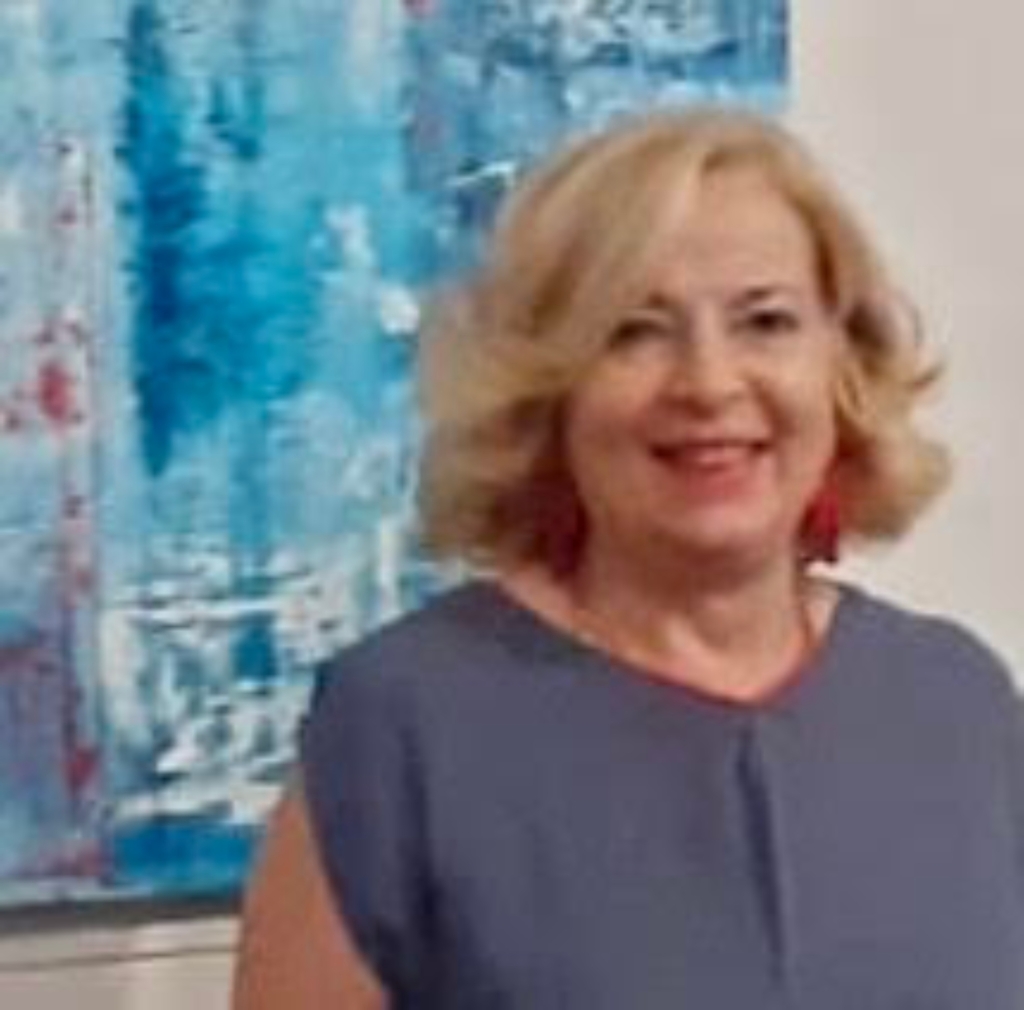
Equilibrata, tranquilla e certa della solidità della sua attitudine verso l’arte, Laura Tosca intraprende fin da giovane il percorso che la accompagnerà per tutta la vita, studiando presso la scuola di nudo e successivamente laureandosi presso l’Accademia di Belle Arti di Brera, percorsi formativi che la indurranno a prediligere uno stile fortemente figurativo e legato all’estetica, a quella bellezza insita nella perfezione delle forme che costituirà per molto tempo la sua cifra stilistica e che le consentirà di partecipare a numerose mostre collettive e personali a Milano, Firenze, Cremona e Berlino. I premi vinti e l’attenzione da parte dei critici nei confronti del suo innegabile talento realista, che l’ha portata a ricevere l’incarico di dipingere i ritratti dei cavalli vincitori del Derby italiano da parte della Società Incremento Razza Equina (S.I.R.E.), non sono però riusciti ad arrestare il suo desiderio di evoluzione e di ricerca artistica che l’ha condotta nel 2016 a spostarsi verso la rinuncia alla figurazione dando vita a un Espressionismo Astratto intenso, travolgente, pieno di tonalità che in qualche modo devo rompere lo schema dell’ordine visivo pur mantenendo un apparente bilanciamento tra le forme indefinite che compongono l’opera. Emerge un approccio alla riflessione da parte di Laura Tosca, malgrado l’impulsività dell’approccio astratto, come se in qualche modo prima di lasciar fluire le emozioni permettendo loro di raggiungere la tela, fosse per lei necessario filtrarle attraverso la consapevolezza, come se dovessero materializzarsi nella sua coscienza prima di poter essere espresse e comunicate; si avvicina al Color Field soprattutto per la bidimensionalità cromatica, quasi come se l’intrusione di una tinta sulla base dello sfondo fosse necessaria per sottolineare la sensazione che l’artista desidera descrivere. Ma la caratteristica che la contraddistingue ancor più delle altre è la tendenza a grattare in maniera più o meno evidente la superficie del colore, in un certo senso cancellando lo strato sottostante per lasciar emergere più incisivamente il concetto, l’emozione che deve conquistare la tela e avvolgere l’osservatore senza alcun filtro se non quello del proprio vissuto, delle proprie risposte ai quesiti sollevati dall’artista attraverso le tonalità scelte di opera in opera. Non si può guardare un dipinto di Laura Tosca senza citare uno dei più grandi e quotati artisti ancora in vita, esponente dell’Espressionismo Astratto tedesco, Gerhard Richter che ha introdotto nel mondo dell’indefinito la tendenza a graffiare via tutto il superfluo, tutte quelle consistenze di colore che attraverso la graffiatura vengono mescolate, fuse a dare un nuovo significato al contrasto tonale. Nella tela Gran granpa
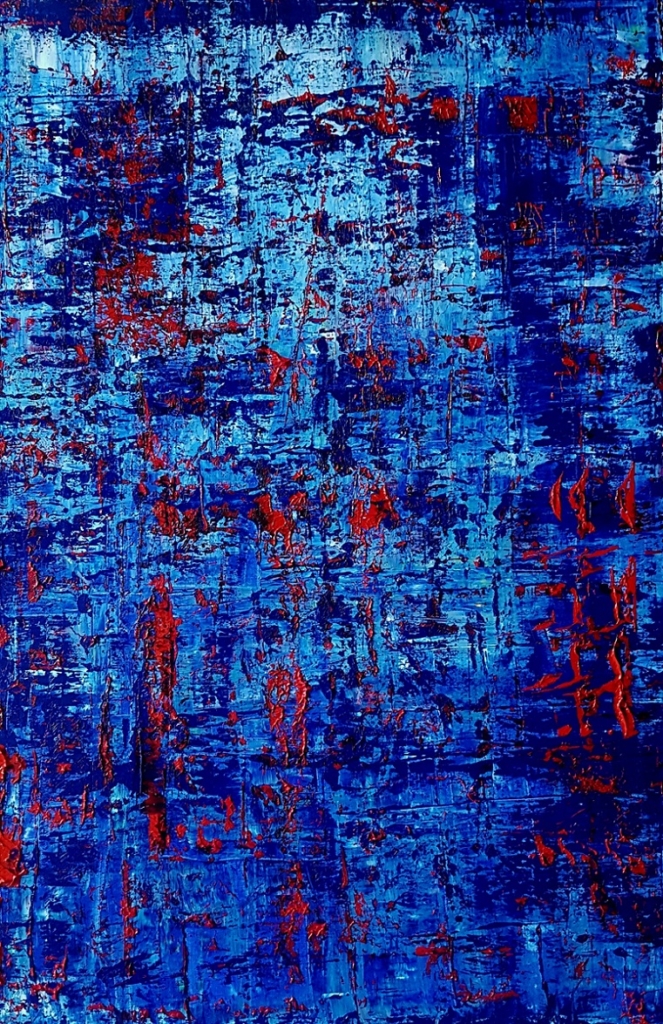
la predominante azzurra, con sfumature verso il celeste, viene disturbata dal rosso per porre un elemento di rottura che dalla calma della meditazione sembra voler scuotere e introdurre la scintilla necessaria all’azione, alla necessità di intraprendere un percorso nuovo in cui abbandonare l’approccio contemplativo e iniziare il cammino evolutivo. Le graffiature orizzontali inducono lo sguardo a lasciarsi rassicurare da un apparente ordine perché in fondo il cambiamento, la modificazione, fa meno paura se non sembra così radicale, sebbene comunque condurrà verso una profonda trasformazione rispetto alla certezza precedente. In Rain and tears
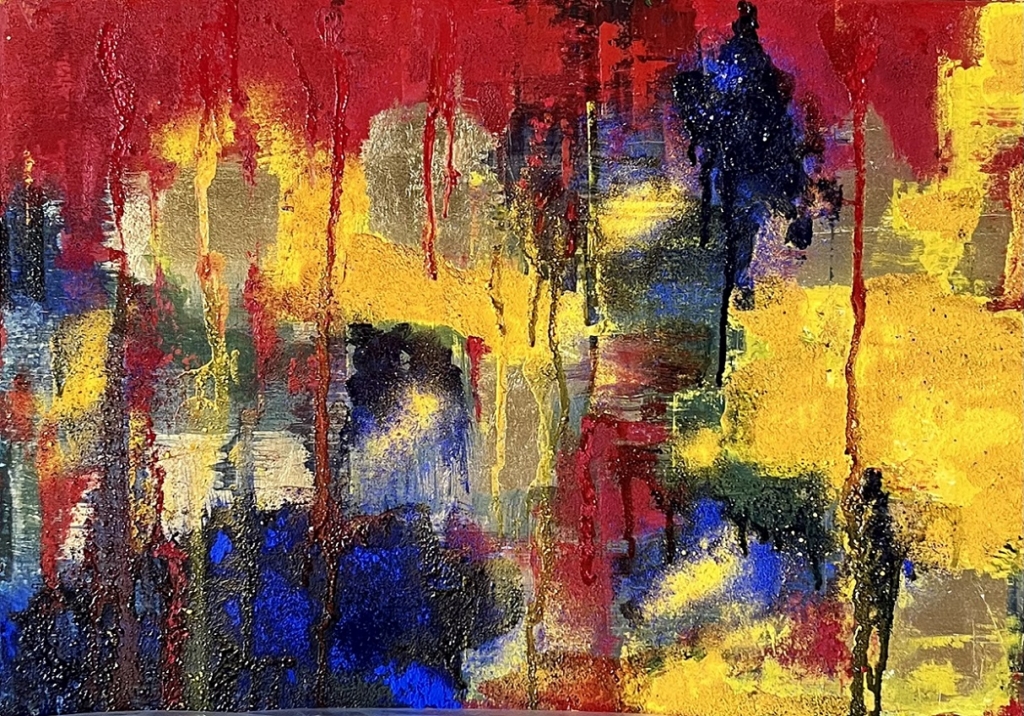
invece le macchie di colore di pigmento puro sono accostate le une alle altre e le colature di legante invadono i livelli sottostanti sovrapposti gli uni agli altri fino all’ultimo strato che viene colato attraverso il Dripping simulando quella pioggia di sofferenza, descritta con il rosso, che scende sulla realtà circostante nascondendo di fatto le lacrime singole, o meglio aggiungendosi a esse, quasi a sottolineare quanto la natura a volte sia in grado di assecondarsi alle emozioni umane, a un sentire nascosto che però si svela solo quando diventa troppo forte e intenso per rimanere in silenzio. Ecco dunque che le energie che ruotano intorno all’uomo si allineano per essere interpreti o, alcune volte, supporto necessario a infondere consapevolezza, a tendere una mano fornendo l’opzione necessaria per generare un cambiamento. Andiamo ora a scoprire di più di Laura Tosca attraverso le domande di questa intervista.
Laura, lei ha avuto un passato artistico fortemente figurativo, cosa l’ha indotta a spostarsi verso uno stile astratto? È stato un passaggio graduale il suo oppure è stato frutto di un’intuizione istintiva che ha saputo ascoltare e seguire?
È stato un momento di stupore anche per me che non avrei mai immaginato, in passato, di giungere all’astrazione. Mi sono resa conto, successivamente, che anni di studio dell’anatomia, di dettagli,
di ricerca della perfezione, avevano contenuto la mia libertà di espressione. Quello è stato un momento decisivo, supportato dal parere positivo di un critico che ha confermato la maturazione di una nuova espressività. La tecnica, la conoscenza dei vari strumenti e supporti della pittura potevano darmi, finalmente, la possibilità di esprimermi senza più ricorrere a modelli esterni, ma potevo materializzare i miei più profondi sentimenti. Dalla profondità dell’anima alla superficie della tela è la frase che uso nelle mie presentazioni.
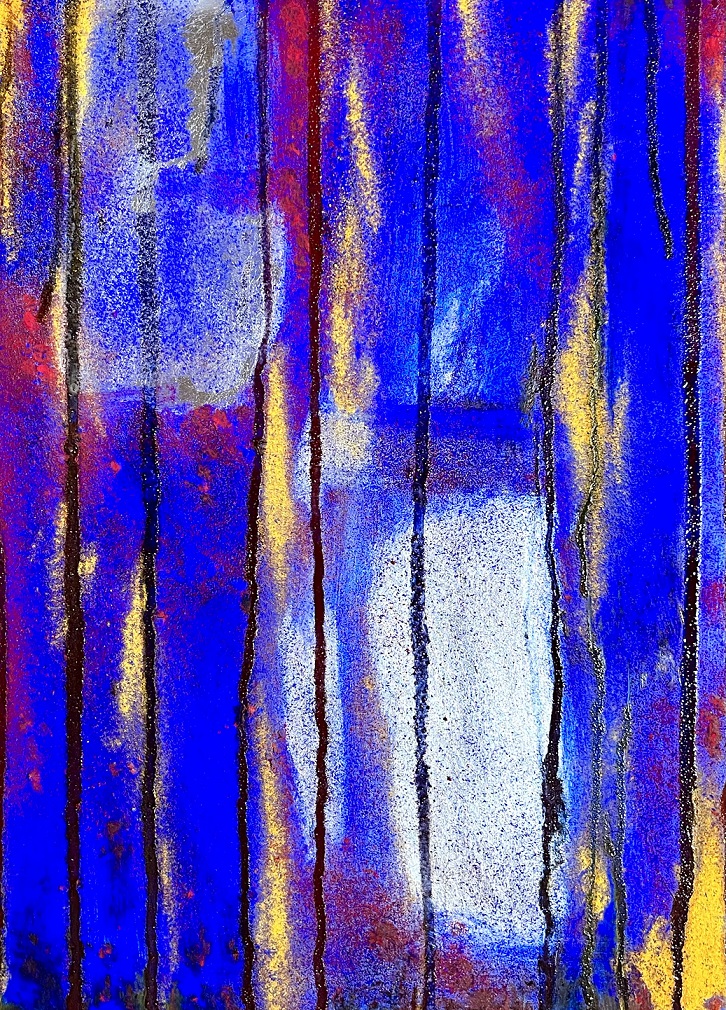
Ci racconta dell’esperienza di realizzare i ritratti dei cavalli vincenti del Derby italiano? Come è riuscita a raggiungere un traguardo tanto importante? Quale suggerimento darebbe a un artista appena uscito dall’accademia alla luce della sua esperienza e nella consapevolezza delle difficoltà e degli ostacoli del panorama attuale?
Si è trattato di un’esperienza di grande soddisfazione e di grandissimo impegno. L’incarico mi è stato affidato dal responsabile della SIRE che aveva visto alcuni miei lavori. Non ho ricevuto alcuna foto dei cavalli e dei fantini, solo l’indicazione della posizione in cui doveva stare il vincitore. Ho studiato l’anatomia equina, chiesto le foto dei cavalli ai rispettivi proprietari e mi sono recata all’ippodromo per fare i ritratti dei fantini. Il tutto in tempi piuttosto ristretti, perciò in qualche modo ha costituito una sfida molto stimolante per me. Il consiglio che posso dare a chi esce oggi dall’accademia è quello di abbinare la padronanza delle belli arti a quello della tecnologia digitale; è indispensabile avere il bagaglio di conoscenze completo e aggiornato.
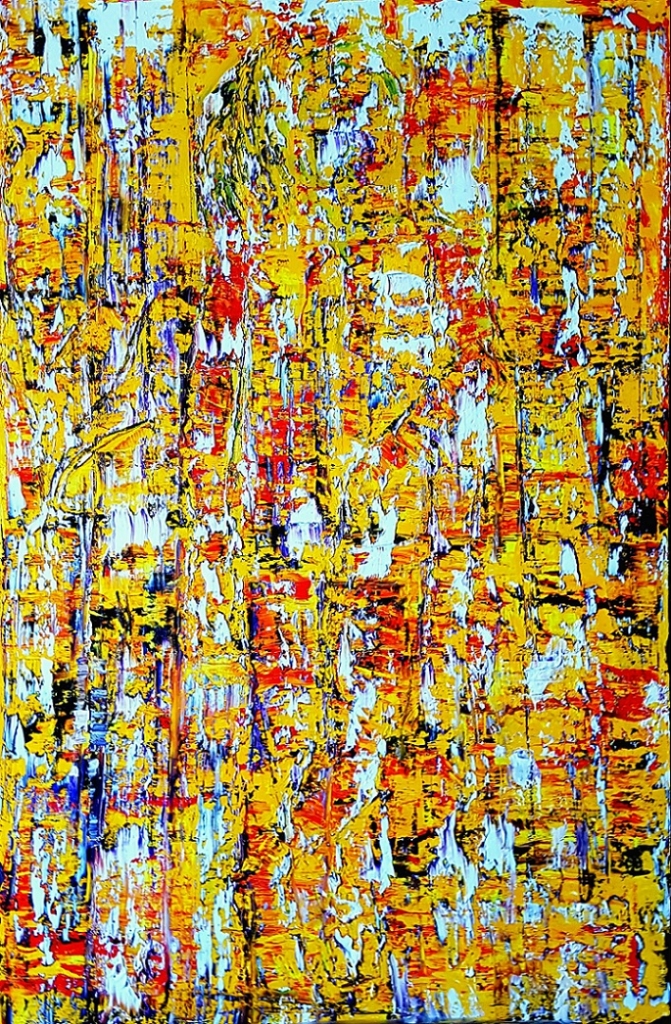
Il suo stile più recente è l’Espressionismo Astratto che ha avuto modo di esporre in diverse città italiane e internazionali; trova che vi siano differenze culturali tra l’Italia e l’estero nel modo di accogliere questo tipo di pittura? Che caratteristiche ha il collezionista tipico delle sue opere?
In base alla mia esperienza l’Italia è più conservatrice, mentre all’estero la mentalità è più aperta e più facilmente ricettiva delle nuove tendenze. I collezionisti storici hanno seguito il mio percorso, apprezzando sia il figurativo che l’astratto mentre i nuovi, quelli che conoscono solo l’ultima parte del mio percorso, si lasciano prendere dalle emozioni che ricevono dalle mie opere.
Guardando i suoi dipinti non si può non notare l’influenza della ricerca di Gerard Richter sulla sua pittura; quali sono stati gli altri maestri del passato che l’hanno ispirata o a cui si sente vicina dal punto di vista espressivo?
Per quanto riguarda il periodo figurativo amo molto Picasso e ritengo che il primo periodo e successivamente il periodo rosa e blu sono meravigliosi. Ho apprezzato e apprezzo molti artisti, ma soprattutto considero Gerhard Richter il più grande artista di tutti i tempi, per la sua ricerca, per le sue sublimi opere figurative e per i grandi Abstraktes Bild che ho avuto modo di vedere dal vero a Potsdam.
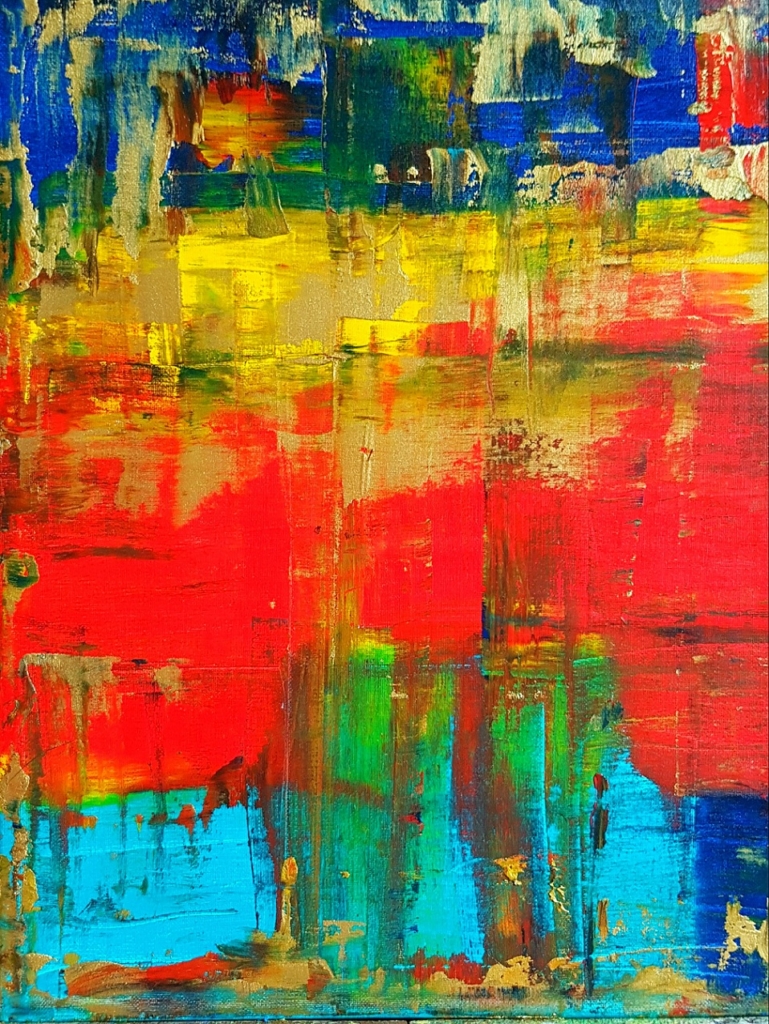
Numerose mostre collettive e personali e innumerevoli premi hanno costellato la sua lunga carriera artistica, ci racconta i suoi prossimi progetti?
La ringrazio per il suo apprezzamento ma vede, quando si hanno riferimenti come Picasso e Richter, è inevitabile e doveroso sentirsi molto umili e sempre in fase di ricerca, di studio e di impegno. Il desiderio nel cassetto è una mostra importante a Milano con le mie nuove opere.
LAURA TOSCA-CONTATTI
Email: tosca.laurag@gmail.com
Sito web: http://www.lauratosca.it/
Facebook: https://www.facebook.com/www.lauratosca.it
Instagram: https://www.instagram.com/lauratosca.art/
Marta Lock’s interviews: Laura Tosca, when revolution passes through abstraction
Balanced, calm and certain of the solidity of her attitude towards art, Laura Tosca embarked from a young age on the path that would accompany her for the rest of her life, studying at the school of nude and later graduating from the Brera Academy of Fine Arts, training courses that led her to favour a strongly figurative style and linked to aesthetics, to that beauty inherent in the perfection of forms that was to be her stylistic hallmark for a long time and that enabled her to participate in numerous group and solo exhibitions in Milan, Florence, Cremona and Berlin. The prizes won and the attention from critics towards her undeniable realist talent, which led her to be commissioned to paint the portraits of the horses that won the Italian Derby by the Società Incremento Razza Equina (S.I.R.E. ), have not, however, been able to stop her desire for evolution and artistic research that led her in 2016 to move towards renouncing figuration, giving life to an intense, overwhelming Abstract Expressionism, full of tonalities that somehow have to break the pattern of the visual order while maintaining an apparent balance between the undefined forms that make up the artwork. What emerges is Laura Tosca’s approach to reflection, despite the impulsiveness of the abstract, as if somehow before allowing emotions to flow by letting them to reach the canvas, it was necessary for her to filter them through awareness, as if they had to materialise in her consciousness before they could be expressed and communicated; she approaches Colour Field above all for the two-dimensionality of the colour, almost as if the intrusion of a hue on the background was necessary to emphasise the sensation that the artist wishes to describe. But the characteristic that distinguishes it even more than the others is the tendency to scratch the surface of the colour in a more or less evident manner, in a certain sense erasing the underlying layer to let the concept emerge more incisively, the emotion that must conquer the canvas and envelop the observer without any filter other than that of his own experience, of his own answers to the questions raised by the artist through the tones chosen from work to work. One cannot look at a painting by Laura Tosca without mentioning one of the greatest and most highly-rated artists still alive, an exponent of German Abstract Expressionism, Gerhard Richter, who introduced into the world of the indefinite the tendency to scratch away all the superfluous, all those textures of colour that through scratching are mixed, fused to give new meaning to tonal contrast. In the canvas Gran granpa, the predominant blue, with shades towards sky-blue, is disturbed by the red to pose an element of rupture that from the calm of meditation seems to want to shake and introduce the spark necessary for action, for the need to embark on a new path in which to abandon the contemplative approach and begin the evolutionary journey. The horizontal scratches induce the gaze to be reassured by an apparent order because, after all, change, modification, is less frightening if it does not seem so radical, even though it will in any case lead towards a profound transformation with respect to the previous certainty. In Rain and Tears, on the other hand, the patches of pure pigment colour are juxtaposed one against the other and the drips of binder invade the underlying layers superimposed one on top of the other until the last layer is dripped, simulating that rain of suffering, described in red, which descends on the surrounding reality, hiding the individual tears, or rather adding to them, as if to emphasise how nature is sometimes able to go along with human emotions, with a hidden feeling that only reveals itself when it becomes too strong and intense to remain silent. And so it is that the energies that revolve around man align themselves to be interpreters or, at times, necessary support to instil awareness, to extend a hand by providing the necessary option to generate change. Let us now discover more about Laura Tosca through the questions in this interview.
Laura, you had a strongly figurative artistic past, what led you to move towards an abstract style? Was it a gradual transition or was it the result of an instinctive intuition that you were able to listen to and follow?
It was a moment of amazement for me too, for I would never have imagined, in the past, that I would reach abstraction. I realised afterwards that years of studying anatomy, of details, of striving for perfection, had contained my freedom of expression. That was a decisive moment, supported by the positive opinion of a critic who confirmed the maturation of a new expressiveness. The technique, the knowledge of the various tools and media of painting could finally give me the opportunity to express myself without resorting to external models, but I could materialise my deepest feelings. From the depth of the soul to the surface of the canvas is the phrase I use in my presentations.
Can you tell us about the experience of making portraits of the winning horses in the Italian Derby? How did you manage to achieve such an important goal? What advice would you give an artist fresh out of the academy in the light of your experience and in the knowledge of the difficulties and obstacles of the current scene?
It was a very satisfying and challenging experience. The assignment was given to me by the head of SIRE who had seen some of my artworks. I did not receive any photos of the horses and jockeys, only the indication of the position in which the winner had to stand. I studied equine anatomy, asked for photos of the horses from their owners and went to the racecourse to take portraits of the jockeys. All in a rather tight time frame, so in some ways it was a very stimulating challenge for me. The advice I can give to people coming out of the academy today is to combine mastering the fine arts with mastering digital technology; it is essential to have a complete and up-to-date knowledge base.
Your most recent style is Abstract Expressionism, which you have exhibited in various Italian and international cities; do you find that there are cultural differences between Italy and abroad in the way this type of painting is received? What are the characteristics of the typical collector of your artworks?
In my experience, Italy is more conservative, whereas abroad the mentality is more open and more easily receptive to new trends. The historical collectors have followed my path, appreciating both the figurative and the abstract, while the new ones, those who only know the last part of my path, get caught up in the emotions they receive from my works.
Looking at your paintings, one cannot fail to notice the influence of Gerard Richter’s research on your painting; which other masters of the past have inspired you or to whom you feel close in terms of expression?
Concernig the figurative period, I love Picasso very much and I think the his early period and later the pink and blue period are wonderful. I have enjoyed and appreciate many artists, but above all I consider Gerhard Richter to be the greatest artist of all time, for his research, for his sublime figurative works and for the great Abstraktes Bilds that I had the opportunity to see from life in Potsdam.
Numerous group and solo exhibitions and countless awards have studded your long artistic career, can you tell us about your next projects?
Thank you for your appreciation, but you see, when you have references like Picasso and Richter, it is inevitable and necessary to feel very humble and always in the process of research, study and commitment. The wish in the drawer is a major exhibition in Milan with my new artworks.

